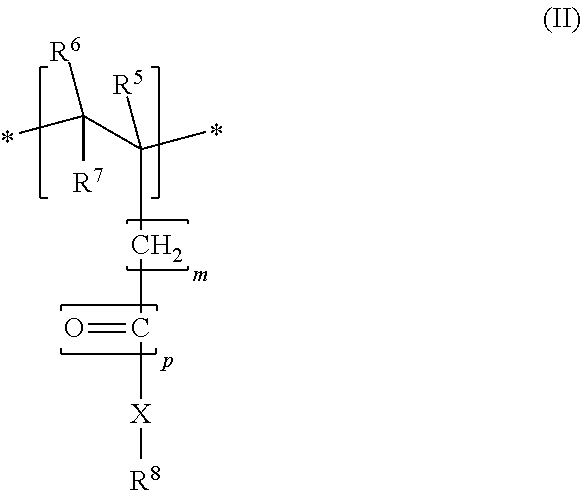Copolymers having phosphorus group-carrying monomeric units
a monomeric unit and phosphorus group technology, applied in the field of copolymer, can solve the problems of complex application, high cost, and inconvenient use of known comb polymers, and achieve the effect of good working of mineral binder compositions and effective plasticization
- Summary
- Abstract
- Description
- Claims
- Application Information
AI Technical Summary
Benefits of technology
Problems solved by technology
Method used
Image
Examples
preparation examples
1. Preparation Examples
[0244]1.1 Copolymer CP1
[0245]For preparation of a block copolymer by means of RAFT polymerization, 28.74 g of 50% methoxy polyethylene glycol-1000 methacrylate were weighed into a 3-neck flask and then diluted with 12.59 g of H2O. A gentle nitrogen stream was introduced into the solution. The reaction mixture was heated to 80° C. As soon as the temperature had been attained, 0.252 g of 4-cyano-4-(thiobenzoyl)pentanoic acid was added. After 10 min, 0.045 g of AIBN was then added. From then on, the conversion is determined regularly by means of HPLC. As soon as the conversion, based on methoxy polyethylene glycol methacrylate, has reached about 90%, 10.71 g of MAPC-1-phosphonic acid (CAS: [87243-97-8]) were added. The reaction mixture is left to stir for a further 3 h. After cooling, what remains is an about 40% reddish solution. The copolymer thus obtained is referred to hereinafter as copolymer CP1.
[0246]The copolymer thus obtained is referred to as polymer CP...
PUM
| Property | Measurement | Unit |
|---|---|---|
| mol % | aaaaa | aaaaa |
| mol % | aaaaa | aaaaa |
| mol % | aaaaa | aaaaa |
Abstract
Description
Claims
Application Information
 Login to View More
Login to View More - R&D
- Intellectual Property
- Life Sciences
- Materials
- Tech Scout
- Unparalleled Data Quality
- Higher Quality Content
- 60% Fewer Hallucinations
Browse by: Latest US Patents, China's latest patents, Technical Efficacy Thesaurus, Application Domain, Technology Topic, Popular Technical Reports.
© 2025 PatSnap. All rights reserved.Legal|Privacy policy|Modern Slavery Act Transparency Statement|Sitemap|About US| Contact US: help@patsnap.com



